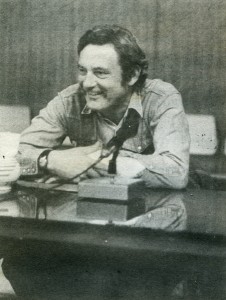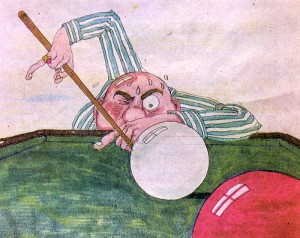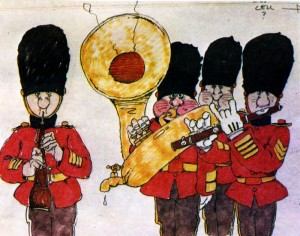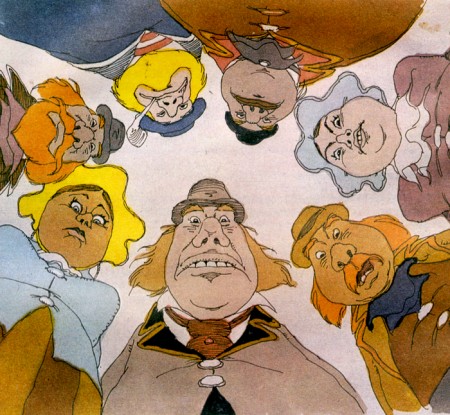Articles on Animation &Independent Animation 17 Jul 2009 07:40 am
Bob Godfrey Interview
Here’s an interview with Bob Godfrey by John Cannon pulled from Animafilm 2/1979.
John Cannon: What do you think of animation as a specific category of film art? What are its capabilities and limitations?
 Bob Godfrey: My answers to it vary with the kind of mood I’m in. It is a very small part of film art and has tremendous capabilities and many, many limitations. One of the reasons for the present state of the industry is that we are not enough aware of the limitations of the medium that we are in. There are lots of things that animation cannot do or shouldn’t do and we seem to be doing them.
Bob Godfrey: My answers to it vary with the kind of mood I’m in. It is a very small part of film art and has tremendous capabilities and many, many limitations. One of the reasons for the present state of the industry is that we are not enough aware of the limitations of the medium that we are in. There are lots of things that animation cannot do or shouldn’t do and we seem to be doing them.
JC: Such as?
BG: The things that live-action handles terribly well like Ingmar Bergman, … personal relationships. In fact live-action is moving into areas that should really be our areas like “Close Encounters of the Third Kind” or “Star Wars”. Animated film should go into the impossible, the fantastic, into the mind of man, because the live-action camera has been literally everywhere it can ___________Bob Godfrey
go on earth — it’s even been to the moon. It’s getting
extremely difficult to amaze people. What cinema has to be into is.
FANTASY AND SPECTACLE. To do spectacular things in animation on a big screen costs a lot of money, a high risk with the decline of the short film, which I lament terribly – the short film is slowly being strangulated by the people who run our business, the distributors. There are no short films exhibited in the principal market, the United States, and very few short films shown here. There’s the old adage “if you want to lose money make a short” and that dies hard in Wardour Street. You can’t get the money to make shorts. Nobody goes to the cinema to see a short – they go to see a long.
 So we as animation producers are being forced (if not forced some of us are going willingly) into one of two areas; television with commercials of forced into making longer films, the long feature-length animated film. One has to think very long and very hard before venturing into this area. Judging by the films I’ve heard about or seen recently we are not coming up with the ‘smash hits’ and unless you’re a smash hit your’re nothing; there’s no longer a place for a B feature. We’re not coming up with the ‘smashes’.
So we as animation producers are being forced (if not forced some of us are going willingly) into one of two areas; television with commercials of forced into making longer films, the long feature-length animated film. One has to think very long and very hard before venturing into this area. Judging by the films I’ve heard about or seen recently we are not coming up with the ‘smash hits’ and unless you’re a smash hit your’re nothing; there’s no longer a place for a B feature. We’re not coming up with the ‘smashes’.
JC: Why not?
BG: Wrong subjects perhaps. Perhaps it should be for the children’s market here. Children are catered for by Walt Disney but I don’t know many other children’s producers. I want to make a children’s musical because I think it’s a good idea, because when you’ve outgrown one audience, in another seven years there’s another coming along.
I don’t say that animation should cater solely for children of the family audience. Look at the work of Ralph Bakshi – he works for the young teenage market, the biggest audience we have, the young people who don’t want to sit at home at night.
There’s been a whole spate of animated films recently from the West Coast of America and I don’t think any one of them has really been the
‘smash’. It shouldn’t be to difficult – at least we’ve got to do something to our audience: if we can’t amaze them, perhaps we can still make them laugh, make them cry. You must engage your audience’s emotions and possibly animation is failing in this.
THE ENTREPRENEURS. In animation tend to be the artists — artists in the sense of an artistic background – and perhaps these aren’t the right people to communicate with audiences. One must be a showman first and an artist second, like Disney. He had the great faculty for giving people what they wanted, whereas today there seems the great tendency for self-indulgence on the part of animation producers. It’s what they want first and what the public wants second. It’s a strong temptation for anybody working in animation.
JC: Can animation still hold the audience? BG: Yes, more than anything. We’re just wasting the medium – a sameness is coming over. There’s a tremendous desire to do a quality product after all the conveyor-belt type stuff we’ve had over the last few years.
There’s reaction against that and a strong desire here in London and the West Coast of America to do the quality product. Against that there is the lack of mone’y, the sheer cost of producing an animated film. We’re exploring ways – that’s what “Great” was, an economical way of doing something at the same time as keeping it moving and keeping it entertaining. In these respects it’s successful – it only cost ‘£ 36,00 to make, not a lot for a half-hour animated musical.
It’s good to continue with the musical but we need good stories… maybe animation’ought to be yanked out of art schools and put into drama schools. That would be a start. There are far too m%y artistic considerations and not enough dramatic or story-structure considerations, that is the trouble. We must rethink plus the fact we have no tradition to fall back on.
JC: Has there been no tradition at all? Where do you place the old ‘classics’ of America animation?
BG: The Disney films and Fleischer films came out of the short tradition. The animation house on the side of the big American distributors.
JC: They all had to have a house cartoon?
 BG: Yes, Warners, UA and that sorl Everyone on the side of the live-action Out of this came the “Silly Symphonies the longer things. Disney is the only one his place with long animation films. Af Disney moved to live-action which si way he was going anyway; he moved “Jungle Book” which was terrific for me. There was another lull after his death and suddenly came up with “Yellow Submarine.”
BG: Yes, Warners, UA and that sorl Everyone on the side of the live-action Out of this came the “Silly Symphonies the longer things. Disney is the only one his place with long animation films. Af Disney moved to live-action which si way he was going anyway; he moved “Jungle Book” which was terrific for me. There was another lull after his death and suddenly came up with “Yellow Submarine.”
JC: Which was a shot out of the blue?
BG: I don’t think it changed anything at all. It was certainly a milestone. We talk about before “Yellow Submarine” and after “Yellow Submarine”.
A very important and good film but somehow synonymous with swinging London, the Beatles, 1967, 1968 and now it doesn’t seem to matter so much, it’s history. It changed nothing because we all suddenly went back to making things that came before it.
BAKSHI’S HAPPENED – a phenomenon. He has tremendous energy and makes more features than dogs have fleas. He does a great amount of work. He’s now doing “The Lord of the Rings.” All he does is interesting. He’s a fantastic foree in our world, extremely good for the industry. We rush to see his latest films here. He’s taken animation out of the slightly infantile area of pigs in sailor hats and animated nursery-rhymes. He’s made it into the urban nightmare… Look at the New York of “Hoppity Comes to Town” and compare it with, say, “Heavy Traffic” and there’s great sociological comment there. It reveals what has happened to a city in thirty years and what has happened to attitudes. Bakshi has brought animation up to date and one must admire him for that. He’s not had a ‘smash’ yet but I hear amazing stories of “The Lord of the Rings” and it being Bakshi whatever I hear, I believe. He’s the saviour of the West Coast. Box-office success it what it’s all about.
JC: Could critics help animation?
BG: You have drama critics, ballet critics, opera critics. You don’t really have animation critics. This is a great pity. I never see an animated film really criticized properly.
JC: Who could do that?
BG: Someone who knows something about animation. We work in a subject there’s a lot of ignorance about. It’s always handled by the run-of-the-mill film critic. We need an Apollinaire, someone to write about us from the inside, perhaps a failed animator turned journalist… We do need some penetrating analysis right now. Animation, because of animation festivals, is terribly incestuous. At festivals – the only place we meet nowadays — we’re
PREACHING TO THE CONVERTED and in a way the pressures on animation have reduced it to the sort of sameness. The days of the house-style of a few years ago have gone. There’s kind of faceless uniformity about it now.
The advertisers have forced their styles onto us here whereas in the past they had to have our style or leave it. There is still a Disney style, they’re the only ones who can afford it and they don’t make commercials.
JC: Haven’t commercials been of positive use beyond keeping some animators is business? BG: It’s a two-edged sword. On balance it has done more harm than good. Well, they’ve kept us alive. We have to look for alternatives although there are studios completely dedicated to producing animation for commercials who would not want to do anything else.
Halas and Bachelor try to get away. I probably do more entertainment than anyone else in Britain. Richard Williams has his films, “Raggety Ann and Andy”. He built up the Pink Panther tradition too when it was fashionable to have expensive titles. In “Charge of the Light Brigade” the animation said it all, I don’t know why we needed the live action! But financial recession has slammed the door of artistic titles in our faces.

All images are from Godfrey’s film, GREAT.
JC: What doors are opening?
BG: Well, the National Script Development Fund have given me money to work out a package to do an animated feature. I have made a couple of successful animated shorts that prove that you can make money out of them, but I don’t want to keep on trying to prove it. It’s too exhausting.
Having proved it, I’m doing one last short with Vladko Grgic in Yougoslavia which I think will possibly be the best short I’ve been associated with. I’d like to take a
HOLIDAY FROM SHORTS. I’ve done more than most people – and get into the longs. I feel I’m equipped to do it because of the two series which were the equivalent of four hours of animation, a hell of a lot. I’m venturing now into a new area for me. I hope I don’t catch a cold.
One must now think internationally. The film “Jumbo” is set in England and New York so this gives it the transatlantic appeal. The trouble with “Great” was it was so English; no-one understood it.
JC: But it won an Oscar?
BG: It won an Oscar but it’s never been distributed in the States; they’ve never heard of Brunei and they’ve only just heard of Queen Victoria. I blame the distribution system. It’s no good making an animated film unless you have good links with a distributor. JC: But,,Great” was fortunate in Britain? BG: It was fortunate in that it was commissioned by British Lion who subsequently went bankrupt… not solely because of “Great”! You must have the guarantee of distribution before you start anything.
JC: What is it like working in Britain now?
BG:. It’s a bit like Dickens, a best of times and a worst of times. It’s amazing now we keep going. One reason it that British animators are among the best in the world – I say that not to bang the drum or rattle the sabre — I believe that. “Yellow Submarine” helped to bring on a generation of, talented animators, mostly spread out in little tiny companies. I’d hate to see them go down because of escalating costs, rents, etc…
IT’S A TERRIBLE STRUGGLE we have to go on, for some there’s nothing else. We’re attracting more work from abroad – France and Germany. I’m working on “Sesame Street” for Kuwait, Nigeria. Africa is opening up – one door shuts, another door opens. I have to keep my ear to the ground and move with the times. The markets and patterns change all the time, but we are still keyed to the side of the advertising industry.
JC: How should animation be taught?
BG: I teach in an art school one day a week and I am anti-art school and pro-drama school. We must avoid the artistic self-indulgent area. I’m guilty of this too because I financed the films myself and why the hell shouldn’t I?
The cult of the director is something out of Europe — not America where one had the great commercial directors who until recently no-one had ever heard of. In the 1960′s they were re-discovered and the French began saying isn’t Howard Hawks marvellous, which of course he was, or Ford, or Wyler. Nobody said the films were great because they directed them. It was out of Europe that we got the ‘artistic’ film and the cult of the director which has been shipped in animation over to Canada which rarely makes it into the commercial cinema.
JC: Are the new technologies offering any new opportunities for animation?
BG: You mean the great video-tape breakthroughs that are always going to happen? The computer animation that will take over the world? It never happens. Basically it is produced now as BY FLEISCHER ALL THOSE YEARS AGO, equipment’s a lot better and we’re standardizing more. There are more and more animation rostrums in London. Let’s hope they all keep busy.
JC: What about animation and television?
BG: Animation goes into television through commercials and is well paid but animation for programmes is poorly paid and consequently we’re not doing well there. The “Muppets” work — they’ve effected the compromise between instant live action and the sheer labour of animation which makes it impracticable for instant television. Television is instant; animation isn’t. Perhaps the demarcations are natural.
Animation belongs in the cinema where we can afford to labour longer and spend more – for television we can’t produce it fast enough or economically enough.
I’ve never liked puppets very much — I’m not exactly a puppetteer – I love Trnka puppets and Pojar but it doesn’t seem to belong in this country; rather in Poland, Russia, Czechoslovakia where there are such marvellous tradition of puppet work. The “Muppets” however, who grew out of “Sesame Street” are superb, really funny. The “Sesame Street” tradition has helped get work on the small screen. I don’t know how we can solve
the major problem though of the very badly paid area of animation for television programmes. That’s why most of the animation on television is of so low a standard, but what can anyone do with a microscopic budget?
JC: We’ve talked of financial limitations a great deal. What of the other limitations?
BG: Animation is still the art of the impossible; it should concern itself with this but so has live action recently. “Close Encounters of the Third Kind” does this and this is what makes it so mind-boggling. It wouldn’t have been believable as animation as it would lose credibility.
People see animation and do not find it offensive. “It’s a doll” or “it’s a cartoon”. We can make dogs talk. We should deal in imaginative situations. My students don’t really think cartoon. They think live-action and you’ve got to really work on them to think like a cartoonist. A lot of students will have a hand come on the screen and move something. I ask “why the hand?”; it’s simple, acceptable cinematic trick to make the thing move by magic. You must condition yourself to the world of Melies, he was so wonderful because he did tricks.
JC: But your persona is not so much a trickster on screen but an everyday ordinary bloke?
BG: Oh, the Stan Hayward/Bob Godfrey syndrome. Yes, he’s your everyday standard man, with a blown mind. His fantasies are extra-ordinary and this is what I’m doing now. My elephant is ordinary – well he’s not ordinary, he’s the biggest elephant in the world – but his fantasies are amazing. It’s the coming together of the fantasy world and the real world. A mad person cannot differentiate between the two; the two worlds merge. But some people, like “Henry 9 Till 5″ keep fantasy in one compartment and reality in another. I like working with Stan Hayward: he’s one of the few people who’s bothered to sit down and think what animation is all about.
JC: How do animators benefit from film festivals?
BG: The thing about festivals is to realise the background against which those films are produced. How difficult it is for Bruno Bozzetto in Italy? What are the difficulties in Czechoslovakia, Moscow, Yugoslavia? You and I are going to Poland so we’ll find out what things are like there. How do animators function UNDER STATE SUBSIDY? There’s a lot more corning here insofar as a lot of the work I do now is short information films for the Central Office of Information. Does the Canadian Film Board work? – yes, because we get wonderful animators like Caroline Leaf. Without the Film Board a woman like Caroline would not get the opportunity to come through and carry on her experiments. There’s nothing like it anywhere else.
In Britain we’ve got the National Film School now which is supposed to be working well and the London International Film School and the arts schools and colleges. A lot of the people working in London are old student of mine from Farnham and Guildford and are moving in. I suppose one person in three gets fixed up in the industry from school. One minute everybody is working, then the film finishes, and everyone is out of work and a great nebulous mass of people move round trying to get absorbed on other things – like musicians here moving form gig to gig, band to band.
JC: Can you tell us something about your new project, “Jumbo”?
BG: It’s a pilot. If I hadn’t done “Great” I wouldn’t be doing “Jumbo”. HE WAS A BIG ELEPHANT, who was around in the nineteenth century. I don’t make films about the nineteenth century through choice. I seem to get lumbered with them. Other people might say I’ve got a size fixation; the smallest man in the world making the biggest ship in the world and now the biggest elephant in the world.
I read Professor Bill Jolly’s book, bought the film rights and applied to the National Script Development Fund and was very lucky and got allocated the money last August. I’m now trying to get the pilot together. I think you always start by trying to make the film the same way as the one you’ve just finished , so I tried to get the old team off “Great” together again, some times with success. With my films there is a sort of continuity. I always start off with making the last one all over again and somewhere through it changes — thank God it changes, otherwise I’d be making the same film through all over again!
“Great” was made in an incredibly disorganised way because it was the first long film I’d ever made. I have to be organised now because we’re only paid to develop the script. So, for my £10,000, I have to produce a story-board, ten to fifteen musical numbers and lyrics and a screenplay. I’m story-boarding with one of my great artists Anne Jolliffe; music is being done by Johnnie Johnson; Colin Pearson who did the lyrics for “Great” is doing the lyrics. It’s a little bit of the old team but learning from our mistakes in the last one.
It’ll run for seventy-five minutes. We’ve got this awful, almost surrealist fact that the elephant got run over by a train and although I’ve been advised to leave it out as it might disturb children I can’t. I’m haunted by this poor beast’s death and I’ve got to put it into the story whether it kills me at the box-office or not. To me why Jumbo is immortal and famous is not because he was big but because he was run over by the train. I’ve tried to make it as funny as I can and have shifted it up to the front of the film. Death can be humorous, it doesn’t have to be incredibly tragic. One of the great twentieth century phobias is death. We’ve had the sexual hang-up and luckily we’re talking or screwing our way out of that one. Death? Why not? Stan Hayward’s making funny films about death and kids go “bang, bang, you’re dead” all the time. If we keep it at that superficial level and at the front of the film so that the kids don’t get too attached to the elephant I think we’ll get away with it.
It is important Jumbo dies. Brunei dies. I seem to be getting stuck with people who die at the high point of the film. Jumbo gave his name to the dictionary, he is synonymous with everything big, enormous, large and wonderful, It’s the story of a simple, everyday, neighbourly elephant who becomes a star, a world-beater, a blockbuster if you like.
I’m at the story-board stage now. I have a love-hate relationship with this stage of a film, it’s the most difficult part of the film after the story – the rest is just shovelling coal. It’s hard work but THE IDEA MAKES THE STORY and this underlines all I’ve been saying in the interview. If the story’s not right you can do all the most brilliant animation in the world and it’s not going to work. The idea must be right.
by John Cannon

on 17 Jul 2009 at 4:27 pm 1.Mark Mayerson said …
In some ways, the interview really shows its age, but Godfrey was very perceptive about the state of the industry and the pitfalls that animation was prone to. Thanks very much for sharing this. It was completely new to me.
The IMDB does not list Jumbo as part of Godfrey’s filmography, so I guess the film never got made. That’s a shame.
on 04 Apr 2012 at 4:47 am 2.William Carey said …
Great interview. GREAT images. What is necessary to obtain a copy of “GREAT”?